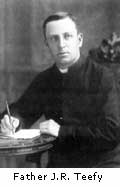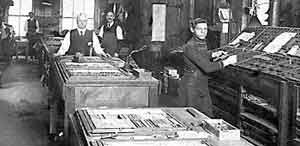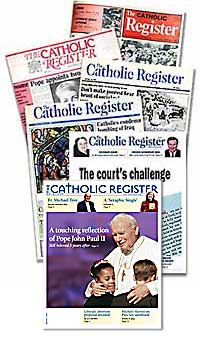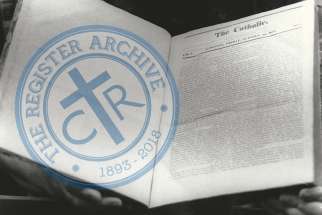The Register Archive: A crowning achievement for Pope Leo XIII
The Register Archive: Canadian clergy march for civil rights
The Catholic Register is 125: In the beginning
The Catholic Register is 125 yearsold on January 5. Since 1893, it has strived to reflect the opinions and the events that have been important to Canada and its Catholic citizens.
Voices from The Register vault: First World War, women's suffrage and anti-Catholic discrimination
Throughout this 125th anniversary year of The Catholic Register, we will be celebrating the rich history of Canada’s oldest Catholic newspaper. This week, rather than our usual Letters to the Editor, we have dipped into the archive to see what issues the newspaper was addressing in 1918 as The Register turned 25 years old.
History of the Catholic Register
The Catholic Register, the oldest English Catholic publication in Canada, was founded in 1893 but its roots reach back 30 years earlier.
In 1863 a newspaper called the Irish Canadian was founded by a Toronto entrepreneur named Patrick Boyle. Four years later a competitor emerged to launch the Catholic Weekly Review, under editor Gerald Fitzgerald. Those two papers co-existed for 30 years (although the Irish Canadian was forced to suspend publication for three months when its editor was jailed for crimes related to Fenian activities).
Conversations between senior Church leaders and the proprietor of the Catholic Weekly Review resulted in an offer to the Irish Canadian and a merger of the two papers. The new entity was called The Catholic Register and its first issue was published on Jan. 5, 1893.

The first editor-in-chief was Fr. John R. Teefy, the Principal of St. Michael’s College, whose mandate was to provide Catholic journalism that put greater focus on Canadian news and events rather than on those happening in Ireland.
In 1909, ownership of The Register passed to the Catholic Church Extension Society, and the paper became known as The Catholic Register and Canadian Extension. It continued to be published in Toronto until moving to Kingston in 1942.
There the paper was amalgamated with the Canadian Freeman, the Montreal Beacon, the Pembroke Crusader and the Northern Catholic of Sault St. Marie and was published under the new name of the Canadian Register. Its role was to provide a high quality journalism and to be a forum for the defence of the Catholic Church in Canada.
The paper returned to Toronto in 1970 and continued to be called the Canadian Register until 1972, when it reverted to its original name, The Catholic Register.
Over the decades, The Catholic Register has been in the forefront of public debates concerning the Church. Whether it be education, military conscription in wartime, the battle against poverty or human rights, The Register pages have been a forum for discussion and presenting the Catholic viewpoint.
The bishops of Ontario have played a vital role in the history of The Register, at times sponsoring it in their own dioceses. They also bought a new press for the paper. In the 1940s a press was brought from England and placed in a renovated two-storey plant at Kingston, Ontario, which served as main printing plant and headquarters of the Catholic press in this province for several decades.

Over the years, the newspaper has changed its ownership structure several times. Currently it is owned by the Archdiocese of Toronto.
Looking back at Catholic papers over the years, one can see that styles and formats have drastically changed. Layouts of early papers would be considered rather heavy and dull by today's standards. Quite often the papers were one-man publications, the editor depending on mail and slow couriers, and using brush and glue to advantage in borrowing from other papers. Compare this with today's Register which gets its news and opinion from staff reporters, freelancers, and correspondents and wire services from across Canada, the United States and Rome.
In the early papers, there were small headings and long columns of type rarely broken by photos. News writing could hardly be distinguished from opinion pieces. At times there were strong defensive attitudes in the opinion columns.
With a change in the social attitudes in Canada, the Catholic papers have developed with a more open, confident look and stance.
A significant change in the direction of the Catholic press came with the Second Vatican Council, which further reflected openness, optimism and ecumenism. In the 1960s and 1970s, a time of enormous upheaval in the Church, the Catholic press often came under sharp attack, even when only reporting storms in the Church.
Today The Register tries to present a broad spectrum of views from within the Catholic community, as well as views from those outside the faith which would, in the opinion of the editor, help Catholics better understand their world.

The onset of the Internet in the 1990s has had a significant impact on all news operations, including The Register. Today, in addition to its weekly print edition, The Register publishes news and opinion daily on its website, www.catholicregister.org. It also maintains a digital edition — a replica version of the print edition which can be read on computers, laptops and mobile devices.
Additionally, The Register uses social media tools such as Facebook, Twitter and Instagram to reach a broad audience that extends far beyond Canadian borders. Many readers also subscribe to The Register’s electronic newsletter, which is sent out weekly.
To mark the 125th anniversary of the newspaper, The Register tackled an ambitious project to digitize every past issue of the paper, from 1893 to the current day, and make those papers available to subscribers over the Internet as pdf pages.






